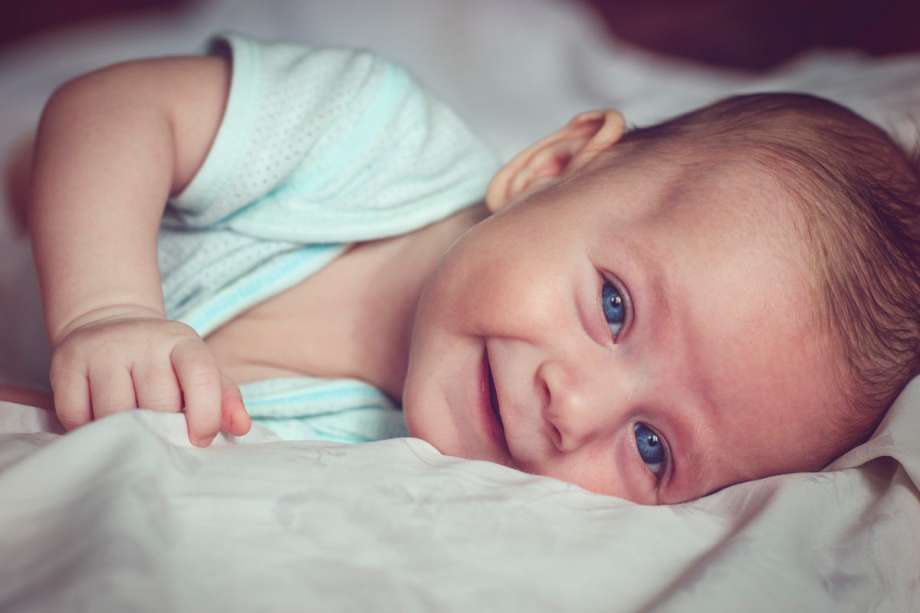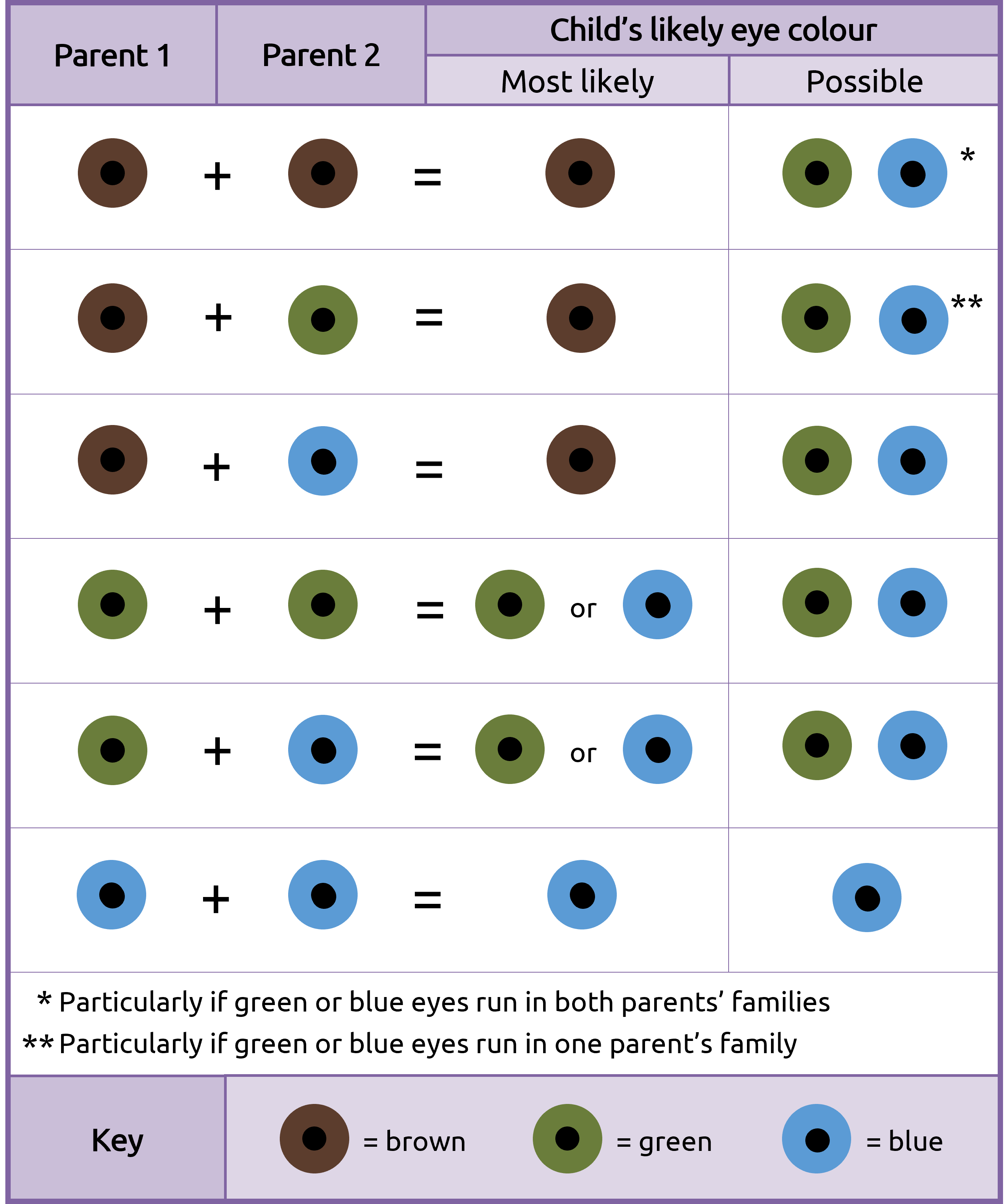Chances of Blue Eyes: A Genetic Explanation & Eye Color Chart

Do you or your partner have blue eyes? Curious if your baby will too? This genetic explanation and handy baby eye color chart can help you answer the question, "Will my baby have blue eyes?”
What eye color will your baby have? When a new addition is on the way, it’s only natural to wonder about their appearance. Will you give birth to a blue-eyed child or one with dark eyes? There is no way to be totally sure about your child's eye color, but you can make a good guess about their genetic makeup.
A History of Blue Eyes
Blue is one of the rarest eye colors worldwide. The genetic mutation behind blue eyes, called Herc2, actually switches off the gene that colors brown eyes, and leaves them blue.
Everyone with blue eyes is related to a single, common ancestor. This ancestor most likely lived close to the Baltic Sea between six and ten thousand years ago and underwent a mutation that left them born with different genes.
Albinism may also be responsible for blue eye color. Ocular albinism can produce blue eyes in people with dark hair color and dark skin color.
The Genetics of Eye Color
People generally have brown eyes, hazel eyes, green eyes, or blue eyes. The exact color of your baby’s eyes depends on how much melanin he produces, which is controlled by the genetic code in our chromosomes.[1]
Melanin is the pigment that colors the human body. Eye color depends on how much melanin is stored in the iris.
Special cells called melanocytes produce melanin. While everyone generally has roughly the same number of melanocytes, how much melanin they produce differs widely from person to person. This accounts for differences in eye color.
There are many different eye colors, existing along a continuum. The least amount of melanin produces blue eyes. More produces green eyes, more than that produces hazel eyes, and even more produces brown eyes, which is the most common eye color worldwide.
Check out our eye color chart below before we continue on and discuss the odds of blue eyes, can two brown eyes make blue, and more!

Predicting Your Baby's Eyes
A more realistic look at eye colors offers the following possible combinations:
- Brown eyes + brown eyes = brown eyes, hazel eyes, green eyes, or blue eyes.
- Brown eyes + hazel eyes = brown eyes, hazel eyes, green eyes, or blue eyes.
- Brown eyes + green eyes = brown eyes, hazel eyes, green eyes, or blue eyes.
- Brown eyes + blue eyes = brown eyes, hazel eyes, green eyes, or blue eyes.
- Hazel eyes + hazel eyes = hazel eyes, green eyes, or blue eyes.
- Hazel eyes + green eyes = hazel eyes, green eyes, or blue eyes.
- Hazel eyes + blue eyes = hazel eyes, green eyes, or blue eyes.
- Green eyes + green eyes = green eyes or blue eyes.
- Green eyes + blue eyes = green eyes or blue eyes.
- Blue eyes + blue eyes = blue eyes.
So really, any combination can result in a blue-eyed child, but only if there are blue eyes somewhere in one of the parents' ancestral lines. This is rare so blue eyes remain rare. But, if both parents have blue eyes or green eyes, the odds are a lot higher. When both parents have blue eyes, the odds are 100%.
Taking a Deeper Look at Eye Color Possibilities
The genetics of eye color is more complicated than just dominant and recessive genes. Eyes come in different colors other than just brown and blue because eye color is controlled by how much melanin we produce.
Parents with brown eyes may give birth to children with dark brown eyes, light brown eyes, hazel eyes, green eyes, or blue eyes. Hazel eyes and green eyes present with specific amounts of melanin, less than what would present as brown eyes.
Blue Eyes Aren’t Really Blue!
Interestingly, blue eyes only appear that way. There is no blue pigment in the human iris or anywhere in the human body. Varying levels of melanin are responsible for eye color. Melanin is brown, and little to no melanin makes the eye color appear blue. When light scatters, the longest wavelengths are blue, so that is what we see. This is the same reason that the sky and the ocean appear blue.
Ancestry as a Clue for Blue Eyes
Will your baby have any chance of being born with blue eyes? Look at your family's eye color background first. People with blue eyes usually have European ancestry, because all people with blue eyes share a common ancestor who was affected by the Herc2 genetic mutation.
If either you, your partner, or anyone in your direct or second line of heredity (parents, grandparents, siblings, or aunts and uncles) has blue eyes, there is a chance that this code is in your or your partner's chromosomes and your baby could be born with blue eyes.
A family history of full or ocular Albinism may also contribute to blue eyes.
Making Eye Color Predictions With Basic Genetics
If you want to try and predict your baby’s eye color, pull out your high school biology textbook to help narrow down just how likely it is that your baby will have blue eyes.
If you didn’t keep it, don’t worry, I’ll give you a quick review. As FamilyEducation’s Genetics Expert, I have developed my knowledge on these topics through a combination of college classes, teaching, and self-study.
We all inherit two copies of each gene (allele), eye color included. One copy comes from our mother and one from our father. Both alleles are stored in our chromosomes (our genetic code) and can be passed on to our children, but only one presents in how we look. Dominant genes are present while recessive genes "hide out" in the DNA code for a chance to pass on to future generations.
Generally, darker colors are the dominant traits, while lighter colors are recessive, so a person with one brown-eyed gene and one blue-eyed gene will have brown eyes. The only way to present blue eyes is to inherit two copies of the blue-eyed gene. However, brown-eyed parents can pass a recessive blue-eyed gene. Therefore, two brown-eyed partners can birth a blue-eyed baby.
Here are the possibilities:
- Blue eyes + blue eyes = 100% chance of blue eyes.
- Brown eyes + blue eyes = 50% chance of blue eyes, but only if the brown-eyed parent carries a blue-eyed gene. If not, the chance is 0%.
- Brown eyes + brown eyes = 25%, but only if both parents carry the blue-eyed gene. If not, the chance is 0%.
It is important to remember that this theory is a simplified version of what really happens at the genetic level. Human eye coloring is actually controlled by a complex genetic process and there are many different eye colors other than just blue eyes and brown eyes.
Blue Eyes Are Not Always Here To Stay
Eye color changes over time. Your baby could be born with blue eyes, but it might not stay that way. In fact, nearly all Caucasian babies have blue eyes at birth. In most cases; however, the eye color darkens over the first year of life. Melanin production kicks in over time, so the baby ends up with green eyes, hazel eyes, or brown eyes.
Can a Baby Have Two Different Color Eyes?
While rare, it is possible to be born with two different colored eyes. This is due to a condition known as heterochromia. Generally, harmless, heterochromia occurs at birth or shortly after.
So will your baby be born with blue eyes? If you or others in your family have them, it is more likely. However, blue eyes are rare. And even if your baby is born with blue eyes, there is no telling if the color will stick.
Curious about other physical traits your baby will have? Here’s How to Predict Your Baby’s Hair Color.
Related: What Are the Chances My Baby Will Have Red Hair? A Genetic Explanation

